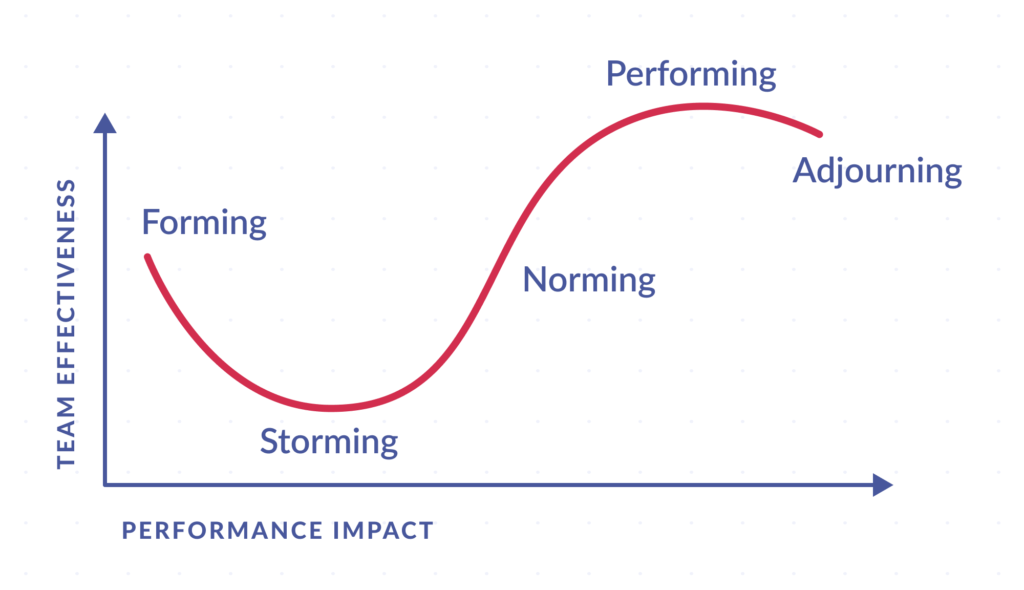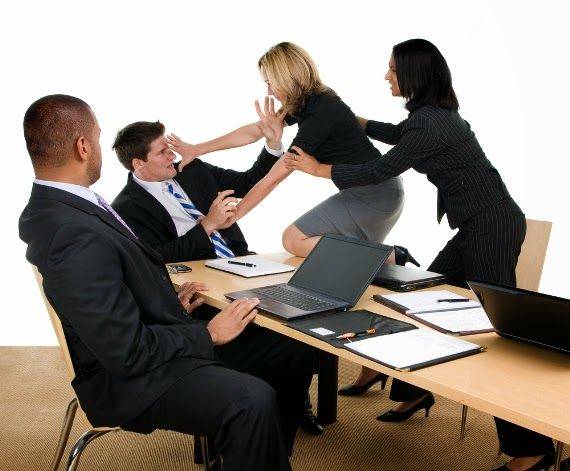Forming, Storming, Norming, & Performing: The Storming Stage
Throughout my 15+ years of working in HR, I have spent a lot of time coaching people on resolving conflicts within their teams. Within even the best teams there always seems to be some drama. Sometimes it is two people really get on each other’s nerves. Other times someone feels like their ideas aren’t valued by the team. Or maybe the team doesn’t like aspects of the manager’s leadership style.
The reality is that conflict and challenging behaviors within teams are things that almost every team experiences. And during exceptionally difficult periods of time, those difficulties will only increase. For example, the extra stress of the coronavirus pandemic or the racial equality protests may have caused some small nuisances to evolve into real issues for your team.
Building your team to high performance has never been more critical, nor more hard. For one thing, it’s not like we can fully go back to the old ways of working together. We have to find a new normal, and we need to recognize that the definition of a high performing team has evolved.
But helping a team work past its conflicts and challenges isn’t just the role of the team leader. All team members should take ownership of how the team is working together, and be willing to put in the effort to improve its overall performance. It is for that reason that I wanted to do a series on how to build team effectiveness. My goal with these articles and tools, is to help you get back to high performance as quickly as possible.
Forming, Storming, Norming, & Performing: The Storming Stage
The 5 stages of high performing teams

While there are many different team effectiveness models, one of the most practical is the Forming-Storming-Norming-Performing model created by Bruce Tuckman in 1965. Tuckman’s model was compiled by comparing the results from 50 different research studies on small team development. There are 5 main stages that every team goes through, or re-goes through in the case of adding a new member to the team. They are:
Forming
The first stage is when the team is initially coming together (or when a new member joins). In this stage, team members can range from positive excitement to anxious energy. During this first stage, team members are learning more about each other and also about what the team is meant to accomplish. The team spends a lot of time discussing the different tasks at hand, how to approach them, and what roadblocks they might face. In order to move to the second stage, team members will need to trust each other enough in order to challenge each other’s ideas and have healthy conflict.
Storming
The second stage of a high performing team, occurs after the team has aligned around the basics (who we are, what we are doing, etc…), and instead focuses on voicing opinions and debating ideas. We call this stage ‘Storming’ because this is the first time where disagreements and personality clashes start to emerge. During the Forming stage everyone is on their best behavior, but in the Storming stage people start being more honest with their thoughts and feelings. The risk of this stage is that some teams can get stuck in a storming mindset. They never resolve their differences, and ultimately the team’s performance suffers.
Norming
If a team is able to resolve its differences and trust continues to be built, then a team can enter the third stage, Norming. At this stage, the team moves past the individual competition amongst the team members, and instead aligns around the common team goals. Team members accept each other (differences included), and a normal way of working together starts to emerge.
Performing
After group norms are established and the team is aligned around common goals, the team can start to reach high performance levels. At this stage, the team members are motivated, excited to be working with the team, and working collaboratively. And since there is high levels of trust, the team freely challenges each other’s ideas and works together to make sure the best idea wins.
Adjourning
The final stage of any team is when the team is coming to a close. Maybe that is because the team has completed its tasks, and the project team is disbanding. Or maybe it’s because a member of the team is leaving the team. But no matter why the team is coming to an end, it is important to recognize and celebrate the team.
Forming, Storming, Norming, & Performing: The Storming Stage
What you need to focus on during the Storming stage

I often think of the Forming stage of a team like the honeymoon period in a new relationship. The team is excited to work together. People are deferring to others and not dominating meetings. Basically, everyone is acting on the best behaviors. But as with new relationships, the honeymoon phase will end, and the true behaviors and opinions of everyone will start to emerge.
The Storming stage of team development is when disagreements and conflicts state emerging within the team. These disagreements might pop up in meetings where people are arguing over the “right” idea. Or maybe the conflict stems from people challenging each other for different roles or responsibilities on the team. In the extreme, the Storming phase can lead the team to challenge the authority of the team leader or even the purpose of the team.
And just like a relationship that is moving past the honeymoon phase, the team has to work through these Storming behaviors in order to reach high performance levels. In order to move from the Storming phase into the next phase, we believe there are three issues they need to address within the team.
Inclusion in decision making
One of the most important factors in creating a high performing team is that the team members feel like a part of the team. A team does not work if people feel separate from the rest of the team, or if there are little factions within the team. High performance requires participation and contribution of all members of the team.
Therefore, it is critical that the team has a culture of inclusiveness and togetherness, especially when it comes to decision making. If only the same few people are part of the decision making process, then the rest of the team might disengage or conflicts might arise because they are not involved. Creating this inclusive culture will help you come together as a team, and weather the Storming stage
Psychological Safety
While a lot of people might not like conflicts and disagreements that come with the Storming stage, I actually think they are a good thing to see. It doesn’t mean we don’t need to address them, but a lack of Storming behaviors can indicate a bigger issue amongst the team, lack of psychological safety. Psychological Safety is described at the ‘condition in which you feel (1) included, (2) safe to learn, (3) safe to contribute, and (4) safe to challenge the status quo- all without fear of being embarrassed, marginalized or punished in some way.” In essence, you feel safe to be yourself and voice your opinions in your team.
When people in the team do not feel psychologically safe, they will not be honest and share their true opinions. They may see a huge mistake in the team’s idea, but will stay silent, leading to an increased likelihood of failure. Or there may be conflict within the team, but no one works to address it. The team members just stew in silence, which may lead to a bigger blowup down the line. Conflict is a natural part of any team, so if you aren’t seeing any in your team, don’t assume it’s a good thing. First check if your team feels safe enough to bring those conflicts to the surface.
Healthy conflict
One of the most critical requirements of a high performing team is that the team can openly discuss and debate ideas. You will not be able to align around the best idea or come up with bold and innovative ideas, if team members are afraid to bring forward their own ideas. Additionally, great ideas are never created in one go. The best ideas are forged when the team works together, and people are willing to challenge the ideas of their teammates. So a critical step in the Storming stage is to figure out how to have a culture of conflict within your team.
But not all types of conflict are good. The main difference between healthy and unhealthy conflict within your team predominantly comes from a difference in mindset within the team. Within an unhealthy conflict mindset, teammates will debate ideas with an “I win / You lose” mindset, and they will believe that team collaboration issues are the responsibility of the other person to change. On the other side, healthy conflict requires a mindset where ideas are debated in order for the team to win, and no one plays the ‘blame game’ with teamwork issues.
Forming, Storming, Norming, & Performing: The Storming Stage
Exercises and Tools that will help your team during the Storming stage

There are many different tools that you can use to build team effectiveness during the Storming stage. Here are 3 of my top recommendations:
How to Run an Inclusive Meeting
Inclusiveness is not something where you can just run one exercise, and instantly everyone acts more inclusively. A truly inclusive culture is something that is built overtime, through many different interactions. That is why we recommend focusing on inclusiveness in your daily activities, and not just the 1 time team offsite. So instead of expecting HR or a consultant to make your team inclusive, you need to take ownership of the process, and make your regular team meetings as inclusive as possible.
Here are some tips that will help you hold more inclusive meetings:
- Make sure everyone knows the purpose of the meeting in advance. This way people can come prepared to the meeting.
- Inclusiveness does not mean inviting everyone to your meetings. Not everyone can contribute if 20 people are in the meeting. Make sure the right people are there, and for the team members who aren’t invited, explain to them the reason why.
- Lay some ground rules, like “no talking over anyone else” and “be present – no checking emails, texts, etc…”. Ideally, you and the team should come up with your own rules.
- If some of the people are in the meeting virtually, ask everyone to switch to virtual. It is too easy for people meeting in person to ‘forget’ about their virtual teammates, and not include them to the same level.
Click here for more tips on Inclusive meetings.
4 Questions that Build Psychological Safety
Psychological Safety is not something that just pops up overnight. It is something that teams need to build by having open and honest conversations. While there are many ways to build psychological safety, we found the easiest method was to discuss (as a team) these 4 questions:
- What are the strengths the team can count on you for?
- Are there some strengths you have that are currently underutilized by the team?
- What is a recent mistake that you made, but that you also learned a lot from?
- What skills or areas of improvement are you trying to develop?
There are two different ways to utilize these 4 questions that build psychological safety. Some teams might want to set aside a full meeting and discuss all the questions in one go. If you have the time, this is a great option as it will keep everyone focused on the overall concept of psychological safety. What you want to avoid is having everyone distracted by other parts of the meeting agenda.
The other way you can run this exercise is to split up the questions across multiple meetings. We don’t want psychological safety to be something you just discuss once. So splitting it across multiple meetings is a great way to keep the concept alive in your team. But no matter which way you choose to discuss them, make sure you block enough time. We believe that 15 minutes per question is the minimum required time to discuss these concepts.
Click here for more information on how to run this psychological safety exercise.
How to have Healthy Conflict
In order to help your team get used to having healthy conflicts when debating ideas, we recommend that you have them spar with each other. A sparring session is a planned debate about an idea or proposed solution. Before the meeting, send the other people the proposal and important background information. Since a sparring session is short and focused, you want the other people prepared to share their feedback.
When starting the sparring session, set some ground rules. Like, the priority should be impactful feedback not just subjective points of view. For example, don’t spend time arguing about the font if the proposal has some serious flaws. Once you have presented the overview of your idea, then invite the team members to challenge it and find the holes in the proposal. Remind them (and yourself) that they are only challenging the idea, and not the person putting forward the idea.
Click here for more information on how to run sparring sessions.
Forming, Storming, Norming, & Performing: The Storming Stage
Don’t skip the Storming stage

The Storming phase does not always occur in every team. Some teams have a tight cohesiveness from the beginning, and no internal conflict or pushback occurs. If you and your team are that lucky, that is great for you, but most teams will go through the Storming phase. I honestly believe that the Storming phase is healthy for teams to go through, especially when they make efforts to be more inclusive, psychologically safe, and have healthier conflicts.
Even if your team is showing no signs of the Storming phase, I would still recommend going through the exercises mentioned above. At worst you are just re-emphasizing things your team already knows and believes. But in the off chance that there was hidden conflicts or distrust amongst the team, these exercises will reveal the hidden storms within your team.
Forming, Storming, Norming, & Performing: The Storming Stage

Leave a Reply